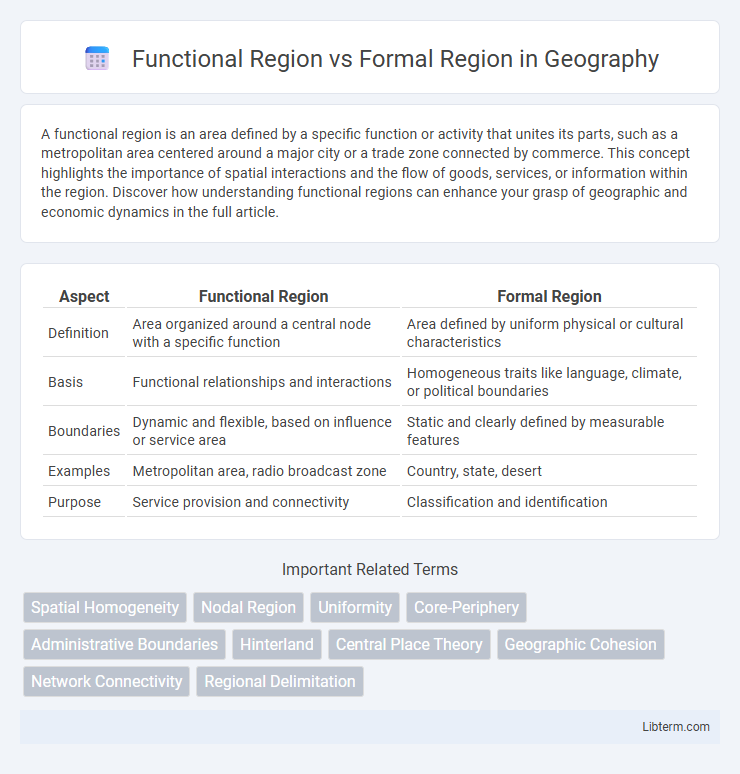A functional region is an area defined by a specific function or activity that unites its parts, such as a metropolitan area centered around a major city or a trade zone connected by commerce. This concept highlights the importance of spatial interactions and the flow of goods, services, or information within the region. Discover how understanding functional regions can enhance your grasp of geographic and economic dynamics in the full article.
Table of Comparison
| Aspect | Functional Region | Formal Region |
|---|---|---|
| Definition | Area organized around a central node with a specific function | Area defined by uniform physical or cultural characteristics |
| Basis | Functional relationships and interactions | Homogeneous traits like language, climate, or political boundaries |
| Boundaries | Dynamic and flexible, based on influence or service area | Static and clearly defined by measurable features |
| Examples | Metropolitan area, radio broadcast zone | Country, state, desert |
| Purpose | Service provision and connectivity | Classification and identification |
Introduction to Functional and Formal Regions
Functional regions are defined by a central hub and the surrounding areas connected through specific activities or interactions, such as economic or social services. Formal regions are characterized by uniform physical or cultural features, like language, climate, or government boundaries, providing clear and consistent attributes across the area. Understanding the distinctions between these regions helps in analyzing geographic patterns and regional behavior.
Defining Functional Regions
Functional regions are defined by a core area linked to surrounding locations through various interactions such as transportation, communication, or economic activities, creating a dynamic network centered around a specific function. These regions are characterized by their focal point, like a metropolitan area with its commuter belt, highlighting the influence of central hubs on peripheral zones. Formal regions, in contrast, are delineated by uniform physical or cultural criteria, such as language or climate, whereas functional regions emphasize connectivity and spatial interactions.
Understanding Formal Regions
Formal regions, also known as uniform or homogeneous regions, are defined by consistent physical or cultural characteristics, such as climate zones, language distribution, or political boundaries. These regions exhibit uniformity in measurable traits like population density, language, or economic activity, which distinguishes them from functional regions structured around a central hub and its connections. Understanding formal regions involves analyzing spatial data patterns and identifying clear, demarcated boundaries where specific attributes remain constant throughout the area.
Key Differences Between Functional and Formal Regions
Functional regions are defined by a central hub or focal point and the surrounding areas affected by its activity, such as a metropolitan area centered around a city. Formal regions have clearly defined boundaries and are characterized by uniform traits, like language or climate, across the entire area. The key difference lies in functional regions being organized around a specific function or node, whereas formal regions are based on consistent physical or cultural characteristics.
Examples of Functional Regions
Functional regions are defined by specific activities or interactions centered around a node, such as metropolitan areas where daily commuting patterns link suburbs to a central city or the broadcast area of a radio station centered on a transmitter tower. These regions contrast with formal regions, which are characterized by uniform physical or cultural traits, like states or countries with legally defined boundaries. Examples of functional regions include the New York City metropolitan area influenced by commuter flows and economic ties or the distribution network of a newspaper serving a defined circulation area.
Examples of Formal Regions
Formal regions are defined by uniform characteristics such as language, climate, or political boundaries, exemplified by countries like France where French is the official language and the government enforces consistent laws throughout the territory. Other examples include the Sahara Desert, characterized by its arid climate, and the Corn Belt in the U.S., identified by widespread corn production driving its agricultural economy. These distinct, measurable attributes create clear and stable boundaries for formal regions, contrasting with the fluid nature of functional regions.
Importance in Geography and Urban Planning
Functional regions, defined by interactions such as transportation networks and economic activities, are crucial in urban planning for optimizing resource distribution and infrastructure development. Formal regions, characterized by uniform physical or cultural traits, help geographers identify areas with consistent environmental or social characteristics for study and policy implementation. Understanding the distinction between these regions improves targeted urban growth strategies and effective spatial analysis in geography.
Application in Real-World Scenarios
Functional regions, defined by specific activities such as transportation networks or service areas, are crucial for urban planning and marketing strategies targeting economic hubs. Formal regions, characterized by uniform physical or cultural traits like language or climate zones, assist in resource management and policy-making that aligns with regional identities. Utilizing functional regions enhances connectivity-based decisions, while formal regions support standardized approaches to governance and environmental management.
Challenges in Delineating Regions
Delineating functional regions faces challenges due to fluid boundaries shaped by dynamic interactions such as commuting patterns, economic activities, or social networks, making precise borders difficult to define. Formal regions rely on consistent, measurable criteria like political boundaries or climate zones, yet disparities in data sources and scale can cause overlaps or gaps. Both region types require integrating diverse spatial datasets, and subjective interpretations often introduce complexity in regional classification and analysis.
Conclusion: Functional vs. Formal Regions
Functional regions are defined by dynamic interactions and activities centered around a focal point, such as metropolitan areas influenced by a central city, whereas formal regions are characterized by uniformity in specific attributes like language or climate within clearly delineated boundaries. The distinction lies in functional regions emphasizing connections and flows of goods, people, or information, while formal regions prioritize spatial consistency and homogeneity. Understanding this difference is crucial for spatial analysis in geography, urban planning, and regional development.
Functional Region Infographic

 libterm.com
libterm.com